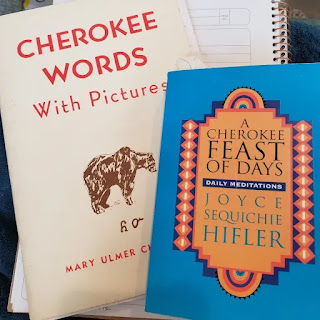Spring greens
This morning I used my little Cherokee dictionary to record some of the traditional plant names in my garden journal. I needed to look up one of the wild greens, Sochani, and was delighted by this article highlighting that following recent changes to laws, the National Park service now allows Sochan and other traditional food and medicine to be harvested by tribal members! The service is cataloging and monitoring plant populations in harmony with this shift.
Sochan is one of many traditional foods and medicines which were wild-harvested, and the people have had limited access for decades!
I first read about Sochan's use in an article on edimental proponent Stephen Barstow's blog. "Sochan is documented as probably the most important spring vegetable of the Cherokee in the Southern Appalachians in Moerman’s Native American Ethnobotany, which is probably where I first noted its edibility. It’s missed in Cornucopia II.
"The Cherokee ate the tender young leaves and stems cooked alone or with other greens such as poke (Phytolacca americana), Ramps (Allium tricoccum), Rumex spp. (docks) and eggs. They were also fried with fat, were dried for later use and also eaten as a cooked spring salad or as celery (presumably raw)."
And, "It is believed to have similar medicinal properties to the closely related Echinacea (also known as coneflower). ... it tastes good, slightly sweet and aromatic similar to other Asteraceae like Korean Aster scaber." (Edible chrysanthemum greens)
My grandmother Minnie Vestella was part Cherokee, and my dad used to gather nettles for her when he went fishing. Sochan doesn't grow wild in Oregon, so she isn't likely to have tasted it.
By 1821, Sequoyah had created a syllabary by dividing Cherokee words into sounds, choosing a symbol to represent each, so a three syllable word only needed 3 characters.
This month the council of the Cherokee Nation signed the permanent reauthorization of the Durbin Feeling Language preservation act (backed by a budget of $18 million)! Language is vital to culture! Gadugi - working together, we can preserve our heritage.
This winter, I ordered 'Golden glow' (Rudbeckia lanciniata) seed from Everwilde Farms, having read Stephen's blog post awhile ago, plus ramps, and Sagittaria - a plant important to NW tribes and in Asian food.






Interesting, Nadya. I haven't heard about edible coneflower before. I love edible(frilly) chrysanthemums and will grow more this spring.
ReplyDeleteI hadn't either veggie reading Stephan's article-
DeleteI intend to grow Edible chrysanthemum this hat as well!
This is so interesting! There are so many edible plants growing in nature that I really don't know much about. It's something that I would love to understand better. Thank you for this introduction!
ReplyDeleteThere are!
ReplyDeleteI was married to a botanist who introduced me to many in our area, and we're both still curious about others!